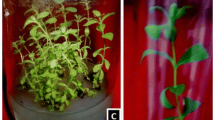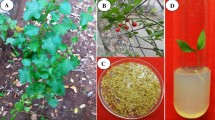Abstract
In the present study, a protocol was developed for the in vitro propagation of a rare medicinal plant, Hedysarum theinum (tea sweetvetch), from axillary buds, and identification of the regenerants was performed with the use of ISSR markers. It was demonstrated that Gamborg and Eveleigh medium supplemented with 5 μM 6-benzylaminopurine was the best for H. theinum for initial multiplication. On the other hand, half-strength Murashige and Skoog (MS) basal medium supplemented with 7 μM α-naphthaleneacetic acid proved to be the best for explant rooting. Molecular genetic analysis of the H. theinum mother plants and the obtained regenerants was performed with six ISSR markers. Depending on the primer, four to ten amplified fragments with sizes ranging from 250 to 3000 bp were identified. Our results confirmed the genetic stability of regenerants obtained in five passages and their identity to the mother plant.
Similar content being viewed by others
References
Krasnoborov, I.M., Azovtsev, G.R., and Orlov, V.P., A new species of the genus Hedysarum L. (Fabaceae L.) from southern Siberia, Bot. Zh., 1985, vol. 70, no. 7, pp. 968–973.
Kurbatskii, V.I., Genus Hedysarum L., in Flora Sibiri (Flora of Siberia), Polozhii, A.V., et al., Eds., Novosibirsk: Nauka, 1994, vol. 9, pp. 153–166.
Volodarskaya, S.B., Vinokurova, E.Yu., and Shul’ts, E.E., Chemical study of Hedysarum theinum, in Fizicheskie i biokhimicheskie aspekty izucheniya lekarstvennykh rastenii (Physical and Biochemical Aspects of Medicinal Plants’ Investigation) (Proc. Int. Conf. in Memoriam of V.G. Minaev), Novosibirsk, 1998, pp. 18–19.
Muruganadan, S., Gupta, J., and Lal, P.K., Immunotherapeutic effect of mangiferin mediated by the inhibition of oxidative stress to activated lymphocytes neutrophilis and macrophages, Toxicology, 2005, vol. 215, pp. 57–68.
Prabhu, S., Jainu, M., Sabitha, K.E., and Devi, C.S.S., Role of mangiferin on biochemical alteration and antioxidant status in isoproterenol-induced myocardial infarction in rats, J. Ethnopharmacol., 2006, vol. 107, pp. 126–133.
Larkin, P.J. and Scowcroft, W.R., Somaclonal variation-a novel source of variability from cell cultures for plant improvement, Theor. Appl. Genet., 1981, vol. 60, pp. 443–455.
Evans, D.A., Sharp, W.R., and Medina-Filho, H.P., Somaclonal and gametoclonal variation, Am. J. Bot., 1984, vol. 77, pp. 759–774.
Venkatachalam, L., Sreedhar, R.V., and Bhagyalakshmi, N., Micropropagation in banana using high levels of cytokinins does not involve any genetic changes as revealed by RAPD and ISSR markers, Plant Growth Regul., 2007, vol. 51, pp. 193–205.
Brito, G., Lopes, T., Loureiro, J., et al., Assessment of genetic stability of two micropropagated wild olive species using flow cytometry and microsatellite markers, Trees, 2010, vol. 24, pp. 723–732.
Das, A., Kesari, V., and Rangan, L., Plant regeneration in Curcuma species and assessment of genetic stability of regenerated plants, Biol. Plant., 2010, vol. 54, no. 3, pp. 423–429.
Gao, X., Yang, D., Cao, D., et al., In vitro micropropagation of Freesia hybrida and the assessment of genetic and epigenetic stability in regenerated plantlets, J. Plant Growth Regul., 2010, vol. 29, pp. 257–267.
Mohanty, S., Panda, M.K., Sahoo, S., and Nayak, S., Micropropagation of Zingiber rubens and assessment of genetic stability through RAPD and ISSR markers, Biol. Plant., 2011, vol. 55, no. 1, pp. 16–20.
Goyal, P., Kachhwaha, S., and Kothari, S.L., Micropropagation of Pithecellobium dulce (Roxb.) Benth.-a multipurpose leguminous tree and assessment of genetic fidelity of micropropagated plants, Physiol. Mol. Biol. Plants, 2012, vol. 18, no. 2, pp. 169–176.
Roy, R., Sajeev, S., Pattanayak, A., and Deka, B.C., TDZ induced micropropagation in Cymbidium giganteum Wall. ex Lindl. and assessment of genetic variation in the regenerated plants, Plant Growth Regul., 2012, vol. 68, pp. 435–445.
Phulwaria, M., Rai, M.K., and Shekhawat, N.S., An improved micropropagation of Arnebia hispidissima (Lehm.) DC. and assessment of genetic fidelity of micropropagated plants using DNA-based molecular markers, Appl. Biochem. Biotechnol., 2013, vol. 170, pp. 1163–1173.
Senapati, S.K., Aparajita, S., and Rout, G.R., Micropropagation and assessment of genetic stability in Celastrus paniculatus: an endangered medicinal plant, Biologia, 2013, vol. 68, no. 4, pp. 627–632.
Siril, E.A. and Joseph, N., Micropropagation of annatto (Bixa orellana L.) from mature tree and assessment of genetic fidelity of micropropagated plants with RAPD markers, Physiol. Mol. Biol. Plants, 2013, vol. 19, no. 1, pp. 147–155.
Smolik, M., R-ISSR-for fingerprinting, mapping and identification of new genomic loci in rye (Secale cereale L.), Russ. J. Genet., 2013, vol. 49, no. 2, pp. 187–195.
Wolfe, A.D., ISSR techniques for evolutionary biology, Methods Enzymol., 2005, vol. 395, pp. 134–144.
Lei, Y., Gao, H., Tsering, T., et al., Determination of genetic variation in Rhodiola crenulata from the Hengduan Mountains region, China using inter-simple sequence repeats, Genet. Mol. Biol., 2006, vol. 29, no. 2, pp. 339–344.
Hakki, E.E., Dogan, B., Duran, A., et al., Phylogenetic relationship analysis of Genista L. (Fabaceae) species from Turkey as revealed by inter-simple sequence repeat amplification, Afr. J. Biotechnol., 2010, vol. 9, no. 18, pp. 2627–2632.
Vysochina, G.I. and Kukushkina, T.A., Biologically active substances from some Hedysarum L. species, Khim. Rastit. Syr’ya, 2011, vol. 4, pp. 251–258.
Murashige, T. and Skoog, F., A revised medium for rapid growth and bioassays with tobacco tissue culture, Physiol. Plant., 1962, vol. 15, no. 2, pp. 473–497.
Gamborg, O.L. and Eveleigh, D.E., Culture methods and detection of glucanases in cultures of wheat and barley, Can. J. Biochem., 1968, vol. 46, no. 5, pp. 417–421.
Zvyagina, N.S. and Dorogina, O.V., Genetic differentiation of Altai-Sayan endemic Hedysarum theinum Krasnob. (Fabaceae) by inter-simple sequence repeat analysis, Russ. J. Genet., 2013, vol. 49, no. 10, pp. 1030–1035.
Elisafenko, T.V., Dorogina, O.V., Achimova, A.A., and Yamtyrov, M.B., Problems of reintroduction and restoration by example of species from the genera Hedysarum L. and Viola L., in Problemy botaniki Yuzhnoi Sibiri i Mongolii (Problems of Botany of Southern Siberia and Mongolia) (Proc. 12th Int. Theor. Pract. Conf.), Barnaul, 2013, pp. 232–234.
Vysotskii, V.A., Biotechnological methods in the production of improved planting material and selection of fruit and berry plants, Extended Abstract of Doctoral Dissertation, Moscow, 1998.
De Klerk, G.J., How to measure somaclonal variation, Acta Bot. Neerl., 1990, vol. 39, pp. 129–144.
Sharma, S.K., Bryan, G.J., Winfield, M.O., and Millam, S., Stability of potato (Solanum tuberosum L.) plants regenerated via somatic embryos, axillary bud proliferated shoots, microtubers and true potato seeds: a comparative phenotypic, cytogenetic and molecular assessment, Planta, 2007, vol. 226, no. 6, pp. 1449–1458.
Rani, V. and Raina, S.N., Genetic fidelity of organized meristem-derived micropropagated plants: a critical reappraisal, In Vitro Cell. Dev. Biol., 2000, vol. 36, no. 5, pp. 319–330.
Murashige, T., Plant propagation through tissue culture, Annu. Rev. Plant Physiol., 1974, vol. 25, pp. 135–166.
Nayak, S. and Sen, S., Differential resistance of three species of Ornithogalum to polyploidization in vitro, Nucleus, 1998, vol. 41, pp. 48–52.
Vendrame, W.A., Kochert, G., and Wetzstein, H.Y., AFLP analysis of variation in pecan somatic embryos, Plant Cell Rep., 1999, vol. 18, pp. 853–857.
Martins, M., Sarmento, D., and Oliveira, M.M., Genetic stability of micropropagated almond plantlets, as assessed by RAPD and ISSR markers, Plant Cell. Rep., 2004, vol. 23, pp. 492–496.
Author information
Authors and Affiliations
Corresponding author
Additional information
Original Russian Text © A.A. Erst, N.S. Zvyagina, T.I. Novikova, O.V. Dorogina, 2015, published in Genetika, 2015, Vol. 51, No. 2, pp. 188–193.
Rights and permissions
About this article
Cite this article
Erst, A.A., Zvyagina, N.S., Novikova, T.I. et al. Clonal micropropagation of a rare species Hedysarum theinum Krasnob. (Fabaceae) and assessment of the genetic stability of regenerated plants using ISSR markers. Russ J Genet 51, 158–162 (2015). https://doi.org/10.1134/S1022795415020076
Received:
Accepted:
Published:
Issue Date:
DOI: https://doi.org/10.1134/S1022795415020076




